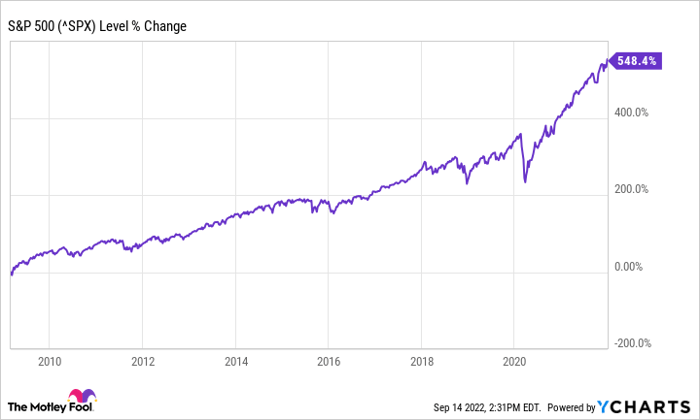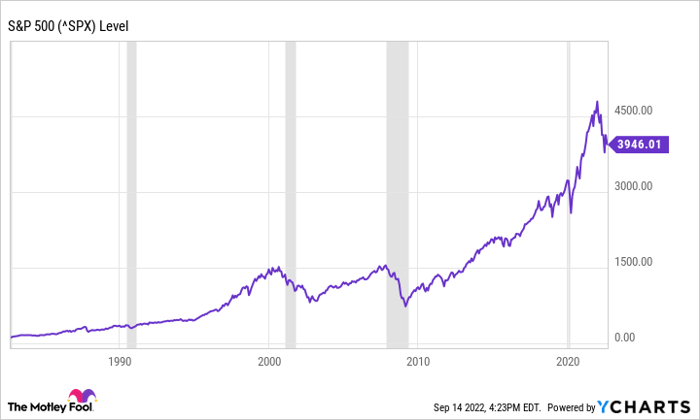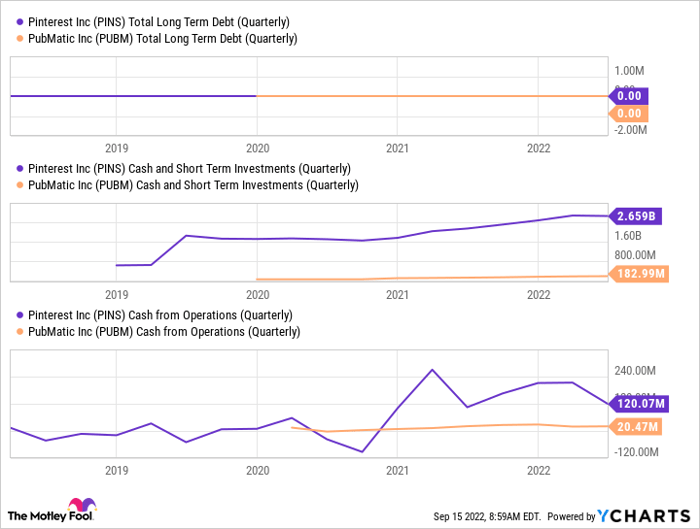This article was originally published on Fool.com. All figures quoted in US dollars unless otherwise stated.
I believe you should buy stocks right now, and I'll support this position with insights from people far more qualified to walk us through this than I am.
With so much uncertainty in the world and in the economy, I know that now can seem like a poor time to invest. But stock pickers could be in a more advantageous position now than they've been for over a decade.
Bull market geniuses or ducks in the rain?
From March 2009 through the end of 2021, the S&P 500 was up over 500%. The march upward only had a couple of brief interruptions, as this chart shows.

If you were buying and holding stocks during this period, it was almost difficult to lose money.
It reminds me of something Berkshire Hathaway Inc.(NYSE: BRKB) CEO Warren Buffett once said. Referencing Berkshire's 34% gain in 1997 in his letter to shareholders, Buffett wrote: "Last year's performance was no great triumph: Any investor can chalk up large returns when stocks soar, as they did in 1997. In a bull market, one must avoid the error of the preening duck that quacks boastfully after a torrential rainstorm, thinking that its paddling skills have caused it to rise in the world."
To restate Buffett's point, almost all investors look like geniuses in a bull market because stocks are going up everywhere -- just buy something. And this is partly due to the broader economy, since there's a strong correlation between that and the market. When the economy is strong, many businesses do well and their stocks go up.
However, we are entering a whole new world in 2022. The U.S. economy has declined for two consecutive quarters. And things could slow further because of the Federal Reserve, as it raises interest rates to combat inflation. As Fed Chairman Jerome Powell recently said, "Reducing inflation is likely to require a sustained period of below-trend growth."
According to Powell, increasing interest rates will continue to slow the economy. But it's also causing the cost of capital to increase, hurting businesses that need financing.
The clock is ticking (for some)
The situation I've described is real. Even companies that have historically burned cash, like Snap Inc.(NYSE: SNAP), are pivoting. When it comes to profits, CEO Evan Spiegel recently said, "We must adapt our strategy accordingly." For this reason, the company is making several changes, including trying to better monetize its augmented-reality (AR) technology by launching an enterprise business.
But many unprofitable companies won't be able to adapt. The dot-com bubble more than two decades ago was a similar situation. The market hit its high in early 2000, but the writing was already on the wall. Talking to Forbes at the time, Ron Sege, then the Lycos CEO, said, "There is a certain sense of desperation and anxiety." Specifically, Sege was talking about insiders' desire to cash out and leave their companies in light of market conditions.
Insiders want out when their ability to generate shareholder value goes down. I believe that's the case right now for structurally unprofitable companies in light of changing economic conditions. As Etsy, Inc.(NASDAQ: ETSY) CEO Josh Silverman recently said, "I think we're going to see a reckoning." The torrential rain for Buffett's ducks is over.
However, if you're thinking about waiting to buy stocks until the shakeout is over, that might not be the best idea. The stock market looks ahead, and it sometimes starts recovering from rock bottom before the economy improves. So unless you know exactly when the economy will recover (you don't), you risk missing the stock market bottom.

To summarize up to this point, bull markets produce stock winners everywhere. Bearish market conditions like right now prioritize profits and disproportionately hurt weaker companies. And finally, timing the market bottom isn't easy. Now, here's what to do with this information.
The strong will get stronger
Sequoia Capital's Alfred Lin recently wrote in a presentation, "The slower growing companies that were doing it profitably now have the financial flexibility to take advantage of the pullback from cash burning companies."
It's like what Motley Fool contributor Brian Stoffel says with his Antifragile Framework for investing: Stocks that are antifragile "get stronger when stress is applied." In other words, the present situation is going to be a long-term benefit for a handful of companies. And if you can identify these opportunities while the market is down, it can lead to some market-crushing results, which is why I believe now is a great time to still be buying stocks.
For instance, investors might take a look at PayPal Holdings, Inc. (NASDAQ: PYPL) stock. With so many unprofitable financial-technology companies out there, PayPal could be in a position of strength. The company has already curtailed spending to boost profits. And at a conference on Sept. 12, CEO Dan Schulman said that earnings per share (EPS) for the current quarter were "coming in a bit stronger than expected." And it's pivoting to greater profitability while still maintaining revenue growth north of 10%.
Image-browsing app Pinterest (NYSE: PINS) and advertising-technology company PubMatic, Inc. (NASDAQ: PUBM) are two more businesses that can still thrive in the current market. Both companies are debt-free, are in cash-rich positions, and generate positive cash from operations, as this chart shows.

PINS total long-term debt (quarterly). Data by YCharts.
Granted, both Pinterest and PubMatic generate revenue from ads. And the advertising industry will likely struggle in a slowing economy. But that's kind of the point. As Lin said, these two have the financial flexibility to grab market share from cash-burning rivals.
In conclusion, investors will need to be more discerning than ever when picking stocks in 2022 and beyond. There are lots of problems, and many businesses will consequently be permanently impaired.
However, this will create amazing long-term opportunities for a select group of companies that I believe will result in life-changing gains over the years to come. I might not accurately identify all of these stocks. But it's why I want to be picking stocks now more than ever.
This article was originally published on Fool.com. All figures quoted in US dollars unless otherwise stated.







